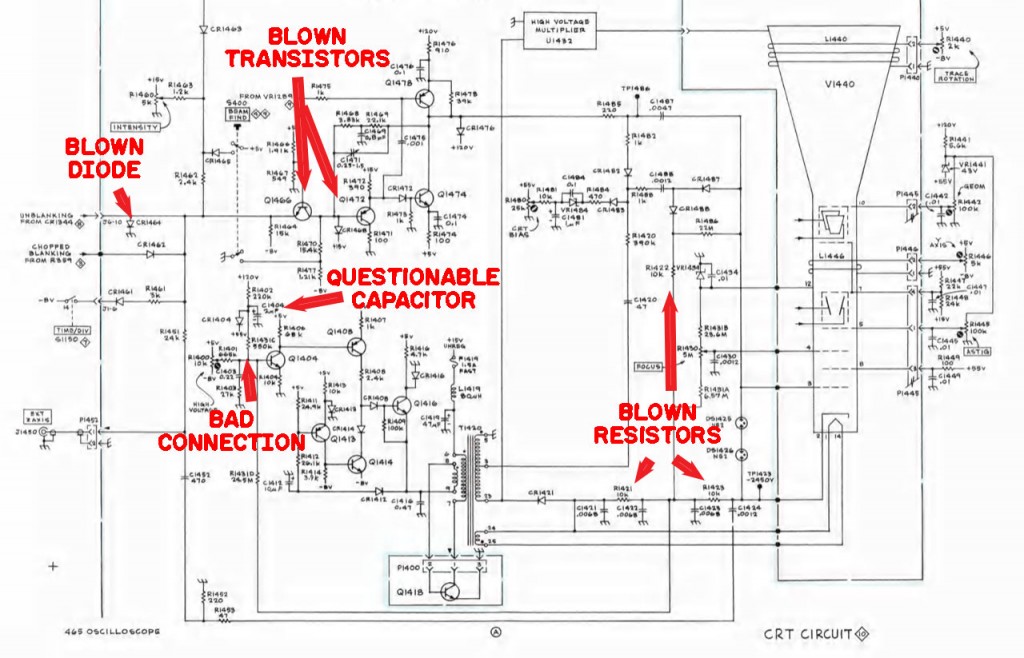Getting my Tek 465 operating correctly again has been quite an involved exercise and to be honest, I considered giving up on it. As related in my previous post, after replacing a questionable electrolytic capacitor, it didn’t come back to life. What really made me consider giving up, is that the problem appeared to be in the high voltage section that drives the tube, as the power supply started making some buzzing noises and the display disappeared. I don’t have proper probes for handling those high voltages and didn’t want to get myself into a dangerous situation.
However, before giving up, I decided to take a look, as best I could. With power off and no high voltages present, I did some poking around with a meter, using the diode checker function to check out transistors and diodes and ohm meter to check out resistors. After a lot of probing, I found that 10K resistors R1421, R1422 and R1423 were all open circuit. They must have all blown like fuses.
After replacing them, I found that the scope still had issues. What could have caused all these resistors to fail, I thought. Eventually, after examining many more components, I found that one of the connections to a custom film resistor was open. This was near the capacitor that I had replaced. I think it must have had marginal contact all along and I must have broken it when replacing that nearby capacitor which connects near one end of this resistor package.

This resistor is used in the high voltage switching supply as part of the feedback circuit. I think this open connection caused the supply to run away and generate too high a voltage which caused the buzzing noise and must have blown out the resistors.
Fixing this contact and replacing the blown 10K resistors seemed to have restored the high voltage as the display now started working and didn’t buzz any more, however horizontal blanking didn’t work correctly. The blanking circuit was less scary to me, as it didn’t involve super high voltages and I dived in.
Probing the blanking circuit, I found two bad transistors, Q1466 and Q1472. It turns out that Q1472 could be replaced by an ordinary 2N3906, but Q1466 used a Tektronix part number 151-223-0. I found that equivalent replacements are either a 2N4275 or 2N5769, depending upon who you believe. However I didn’t have either in stock. I found the same part was used elsewhere in the scope and decided to try a swap to see if I could get further in the debug. It’s convenient that the transistors in this scope are socketed.
After swapping, I found that I still had a problem in this part of the circuit. After much digging, I finally found that diode 1464 was also blown. Well it was actually internally shorted and acting as a low value resistor instead of a diode. This was another part that I didn’t have in my stash, a Tek cross reference page called for a 1n4244. It turns out that this is a diode with a 750 pico second recovery time, rather fast, which I assume is necessary in order to switch the blanking on and off quickly.
At this point, I decided to call it a night and to find correct replacement parts before preceding further. I found that someone in Oregon had the exact Tek part number 151-223-0 for Q1466 and I found another vendor had the 1N4244, though I had to order some additional parts in order to make up a minimum order for this particular order. I have been meaning to build a SCELBI quick loader box and needed some toggle switches for that application, so I tacked an order of 8 toggle switches onto this order to make up the minimum amount.
Last, I swapped back the good 151-223-0 to its original location and set aside the scope. You don’t want to be swapping these parts around willy-nilly, as it can ruin calibration.
It will be interesting to find out if the scope will be finally be made good when the new parts arrive.
